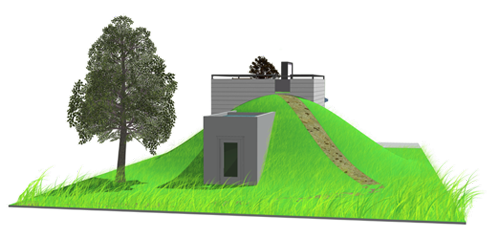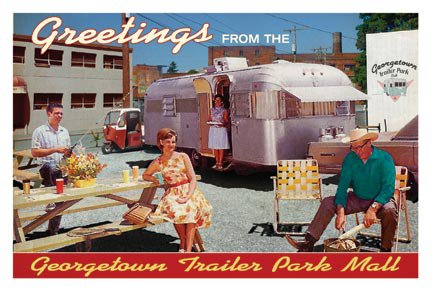Last weekend, cultural historian, art lover, and food enthusiast Nell and I explored Georgetown with a group of about fifteen. Our walking tour was offered by Nell’s company, Localist, which creates customized itineraries for visitors coming to Seattle, and cosponsored by Friend of Georgetown History. We started with some background about the south Seattle neighborhood’s early history: its transformation from a Duwamish settlement with the coming of white Americans in the second half of the nineteenth century, the storied past of its beer breweries and its reputation as a place of revelry (Seattle Presbyterian Reverend Mark A. Matthews went as far as to call Georgetown “the cesspool of Seattle”), its vote to annex to Seattle in 1910, and the rerouting of the Duwamish River that transformed Georgetown’s physical landscape in the early twentieth century. One idea that emerged in our research and conversations was the notion of a palimpsest, a writing surface on which the original writing has been effaced to accommodate later writing, though traces of the earlier hand still remain. When applied to the built environment, a palimpsest evokes the idea of a layering of man-made inscriptions on the landscape. We saw this often in Georgetown, as, for instance, chef Matthew Dillon converted a Spanish Eclectic style house into the Corson Building, a celebrated restaurant, or gardener Jon Dove lovingly adapted a 1905 home into the site of his award-winning garden, giving stones from the nearby ruins of the Old King County Hospital second lives as garden steps.
What Nell and I found in contemporary Georgetown is a community that really sees itself, happily so, as a bit off the map, an area all its own. Fantagraphics Books curator Larry Reid has described the neighborhood as “really the last outpost of any blue-collar, bohemian arts culture in Seattle.” It is a place where people know, support, and regularly kick back with their neighbors.
Here are details from a few of my favorite stops on the tour:

Hat ‘n’ Boots at its new location in Oxbow Park. Image courtesy of A Million Cool Things to Do in Seattle.
These boots are meant for walking, and that’s just what they did. Georgetown’s Hat ‘n’ Boots was created in 1954 by Seattle artist Lewis Nasmyth as part of a cowboy-themed gas station called “Premium Tex.” The service station was sited along Marginal Way on the west side of the neighborhood near U.S. 99, then Seattle’s principal north-south highway. Motorists paid for gas at the Hat, which served as the station office, and found restrooms in the his and hers Boots. When construction of Interstate 5 was completed in 1962, Highway 99 was relegated to secondary status, and Premium Tex eventually closed in 1988. The sculptures fell into disrepair. The brim of the Hat became a favorite site for skateboarders, and they eventually cracked its brim. Then in 2002, the Georgetown Community Council raised funds and obtained title to the historic structures. In conjunction with Seattle Parks and Recreation, the council moved Hat ‘n’ Boots in December 2003 to Oxbow Park, named for the u-shaped Duwamish River that snaked through Georgetown before it was redirected. Restoration on the Boots was complete in 2005, and the Hat was restored in 2009. Expropriated from their original purpose as roadside attractions, these sculptures are now quirky visual anchors for a public park that also features community gardens.
Just two and a half blocks east, on the corner of South Warsaw Street and Ellis Avenue, artists John Sutton, Ben Beres, and Zac Culler, who collectively call themselves SuttonBeresCuller, are working to convert the site of an abandoned 1930s gas station into a tiny city park with a small community center. Their plans call for a building embedded in a fake grass hill. It will be open, available, and free for public events. If you go there now, however, you won’t see anything. The artists are having trouble securing permission to work on the brownfield site because of issues of contamination as well as difficulty obtaining the necessary funding to pay for clean-up, so it remains to be seen whether their Mini Mart City Park will actually go forward. When I spoke to John Sutton last week, though, he sounded cautiously optimistic about the project’s future.
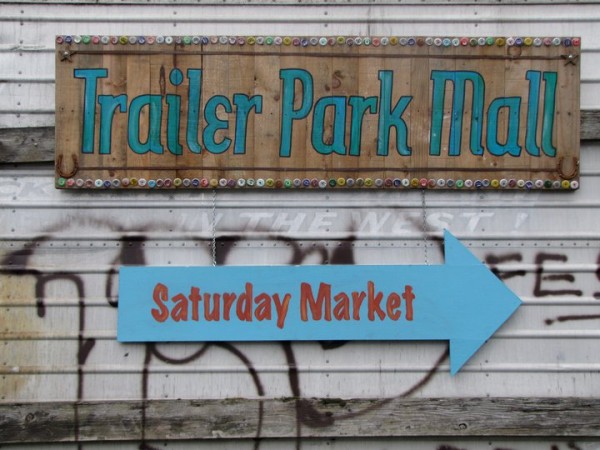
Pointing you to the Georgetown Trailer Park Mall’s Saturday Market. Image courtesy of the Georgetown Trailer Park Mall; photograph by Eric Edwards.
Sited in a parking lot along Doris Street, the Georgetown Trailer Park Mall is an unusual breed of commercial center. Its shops feature vintage items, art, and handmade curiosities, including Frida‘s embroidered patches and tee-shirts, set up in old travel trailers, many of them Airstream. The mall also includes street eats sold out of roaming food trucks, which have exploded in recent years in cities like Seattle and Portland. One of them, Where Ya at Matt, which serves New Orleans soul food and makes a regular lunchtime appearance at the Georgetown Trailer Park Mall on Thursdays, was named by Seattle Magazine as one of the city’s best new restaurants of 2011. At the end of last month, Smithsonian Magazine singled it out as one of the twenty best food trucks in the U.S. The Georgetown Trailer Park Mall is an apt example of what urban theorist Margaret Crawford calls and celebrates as Everyday Urbanism. It is an ad hoc, provisional microeconomy that has inserted itself within a more permanent built environment. Compared to the history of north Seattle’s Northgate Center, opened in 1950 and symptomatic of a postwar trend in shopping centers anchored by the presence of large department stores and accessed via the high-speed freeway, the Georgetown Trailer Park Mall’s eclectic small shops celebrate a Do-It-Yourself mentality and attract serendipitous and savvy pedestrians alike.
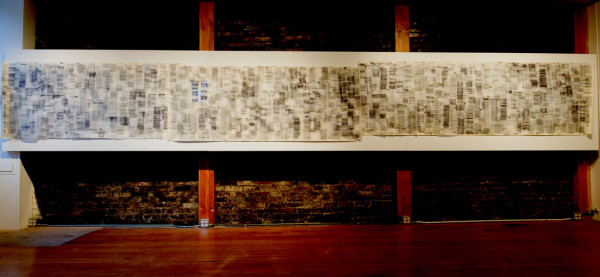
Sharon Arnold’s Mapping an Irretrievable Field of Memory at The Firm, ink, charcoal, acetate, vellum, and scotch tape, 2011. Image courtesy of the artist; photograph by Chad Emerson.
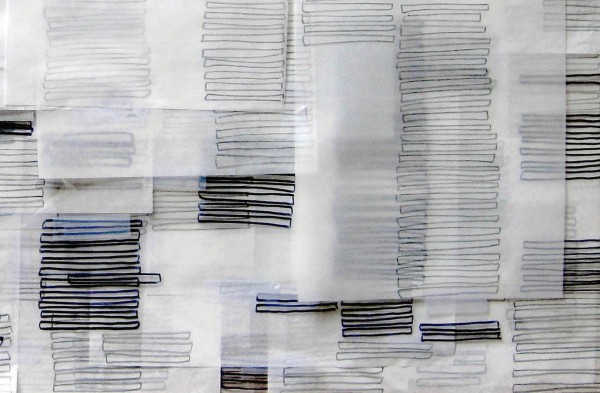
A detail from Sharon Arnold’s Mapping an Irretrievable Field of Memory. Image courtesy of Joey Veltkamp’s Best Of: A Northwest-centric Art Blog.
Artists Michele Lee McMullen and Sharon Arnold welcomed us to our last stop, The Firm. In 2011, McMullen, husband Chris McMullen, and Steve Withycombe moved across the street from their studios in the old Rainier Brewery into the space that used to be Lucky’s Choppers, a motorcycle dealer. They recently converted their storefront area into a gallery showing work by local artists. We happened to be there on the last day of Sharon Arnold’s great show “Mapping An Irretrievable Field of Memory.” Arnold is a Seattle-based artist, curator, writer, and graduate of Cornish College of the Arts. For her show at The Firm, she drew on influences from Minimalism, the study of language, and cartography to explore the idea of accumulation. You can see this in the layers she’s built up with horizontal forms on single sheets and then with the overlapping folios of acetate and vellum mounted on the wall. Arnold has said of her practice as an artist, “I am building a map. I am leaving a trace. You are walking it with me, caught in the process, reliving its making. And if I am successful, you are making your own, and finding your way.”
There are some especially good times to find your way to Georgetown. On the second Saturday of every month, artist studios and galleries open their doors from 6-9 p.m. for Art Attack. Keep your ears to the ground about a June carnival with live music, power tool races, and a beer garden. In July, return for the seventeenth annual Georgetown Garden Walk, scheduled for the first Sunday of the month. Last year, more than thirty gardens were featured. And at the end of October, Friends of Georgetown History will offer its annual Georgetown Haunted History Tour.
I wish you happy exploring!
